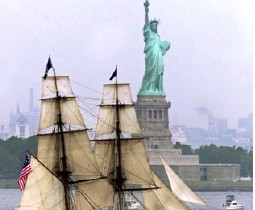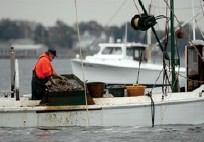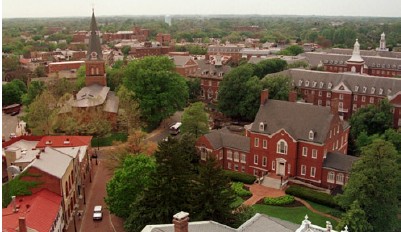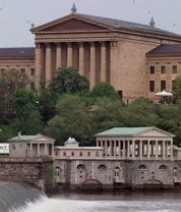

Although the smallest region geographically and one not blessed with large expanses of rich farmland or a mild climate, New England played a dominant role in American development. From the 17th century until well into the 19th, New England was the country’s cultural and economic center.
The earliest European settlers of New England were conservative English Protestants, many of whom came in search of religious freedom. They gave the region its distinctive political format—the town meeting (an outgrowth of meetings held by church elders) in which citizens gathered to discuss the issues of the day. Even though only men who owned property could vote, town meetings afforded New Englanders an unusually high level of participation in government. Such meetings still function in many New England communities today, although of course they now include women.

The two-masted sailing ship Niagara from Erie, Pennsylvania, passes by the Statue of Liberty in New York Harbor.
New Englanders found it difficult to farm the land in large lots, as was common in the South. By 1750, therefore, many settlers had turned to other pursuits. The mainstays of the region became shipbuilding, fishing, and trade. In their business dealings, New Englanders gained a reputation for hard work, shrewdness, thrift, and ingenuity. These traits were useful as the Industrial Revolution reached America in the first half of the 19th century. In Massachusetts,Connecticut, and Rhode Island, for example, new factories sprang up to manufacture goods such as clothing, rifles, and clocks. Most of the money to run these businesses came from Boston, which was the financial heart of the nation.

Waterman Joe Stone sifts through oysters on his boat while dredging on the Patuxent River in Solomons, Maryland.
In recent times, this populous region has lost many of its industries to states or foreign countries where goods can be made more cheaply. The region’s economy has, however, rebounded with the growth of the microelectronics, computer, and biotech industries. Education, high technology, financial services, tourism, and medicine continue to drive the regional economy.
New England has always supported a vibrant cultural life, with institutions like the Boston Symphony Orchestra and the Museum of Fine Arts. Education is another of the region’s strongest legacies. Its cluster of top-ranking universities and colleges is unequaled by any other region. These top schools include Harvard, Yale, Brown, Dartmouth, Wellesley, Smith, Mt. Holyoke, Williams, Amherst, and Wesleyan, to name but a few.

Annapolis, Maryland, is the state capitol and home to the United States Naval Academy. The governor’s mansion is seen in the lower right, and St. Anne’s Episcopal Church, which was established in 1692, is on the left. The current building was completed in 1859.
An important historical literary work from this region is Thoreau’s Walden; or, Life in the Woods. New England was also home to poets Emily Dickinson and later Robert Frost, as well as to Harriet Beecher Stowe, whose Uncle Tom’s Cabin is credited with having given impetus to the abolitionist movement.
Students walk across the green at Dartmouth College in Hanover, New Hampshire. Dartmouth, founded in 1769, is a private, liberal arts college and member of the prestigious Ivy League.

The Philadelphia, Pennsylvania, Museum of Art looms above the Fairmont Water Works along the Schuylkill River. Built in 1812 as a pumping station to bring clean water to the city’s residents, the water works is now a restored historical landmark open to tourists.
The Block Island north lighthouse is located in New Shoreham, Rhode Island. The area has become a tourist haven visited by tens of thousands each year.
As some of the original New England settlers migrated westward, immigrants from Canada, Ireland, Italy, and Eastern Europe moved into the region. Despite a changing population, much of the original spirit of New England remains. This can be seen in the simple wood frame houses and white church steeples that are features of many small towns, and in the traditional lighthouses that dot the Atlantic coast.
New England is famous for foods like clam chowder, Maine lobsters, Vermont maple syrup, turkey, Boston baked beans, and Boston cream pie.



















